Storing Oil Paintings
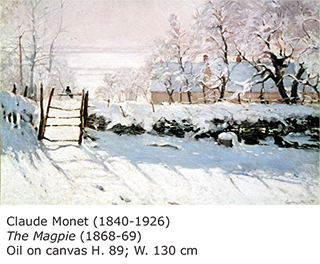
A walk through any great museum leaves you with the impression of the permanence and power of oil painting. Oil painting is the most natural and enduring of all painting media, with that said, it’s worth taking proper care of paintings too. The first side bar has links from the Smithsonian Museum Conservation Institute to recommendations on care and storage of artworks, we recommend you check these out in addition to the information below.
The information below is about one aspect of storage: the change in color of oil paintings in dark storage, that recovers when brought back into the light.
Oil painters can amass a number of paintings. And we are then faced with the issue of where and how to store the artwork. Understanding the lessons from the 550 years of oil painting we know that oil paintings age best in stable and moderate environments. This includes moderate temperatures and humidity, and a moderate amount of light. The general recommendation from the Smithsonian is for dark storage, but oil paintings can take continuous light exposure, in fact light exposure is good for the binder.
The color of a drying oil in a finished paint (linseed, safflower, walnut, and even alkyds) changes in response to the amount of light. Light exposure bleaches oil, and in the dark, drying oils increase in color. It is important to understand that for the vast majority of paintings and the vast majority of storage conditions these changes are imperceptible.
Nevertheless, we decided to study and measure this phenomenon for ourselves: the change in the color of oil in relation to light levels. Henry Levinson, who founded Permanent Pigments in 1933, had done a similar test, the results were published in the 1970’s. (1)
Box 1
Basic recommendations from the Smithsonian Museum Conservation Institute on storing art work of all kinds:
- In relative humidity of 45-55%
- In a temperature range of 65-70 d F
- And in darkness
For complete recommendations for hanging and storage of artwork consult these three web pages:
Storage of Art: https://www.si.edu/mci/downloads/RELACT/storage_documents.pdf
Caring for your paintings: https://www.si.edu/mci/english/learn_more/taking_care/care_painting.html
Care of Acrylic paintings: https://www.si.edu/mci/english/learn_more/taking_care/acrylic_paintings.html
To add to that we have a few specific recommendations for oil paintings:
When storing or shipping paintings one should avoid having plastic or “bubble wrap” in direct contact with the surface of the artwork. These wrapping materials can stick to the surface and leave an impression in the paint or varnish. This is especially true in hot weather.
We recommend varnishing paintings with Gamvar before being put into storage; any dust that accumulates on the painting can be easily cleaned off the varnish layer rather than trying to clean the actual paint layers of an unvarnished painting.
Change is the Rule
The exact color of an oil painting is constantly changing in response to levels of light. Robert Gamblin learned this many years ago when he had drawdowns of the whites we make on his office wall. Each month he would measure the color with our spectrophotometer, and then graph the results. He was looking for any meaningful change in color. Instead, he found the smallest up and down movements in the measurement of color. In time, Robert realized that the drawdowns were responding to the weather, the movements he saw were in response to the amount of sunshine coming through his window.
The two charts below show the change in brightness in just one white oil color, Titanium White, over a year’s period, as the oil slightly changes color in response to the quantity of light that it is receiving. What you see in the charts are just the L* value (lightness, which goes from 1-100) in an L*a*b* system of color measurement. (See Box 2)

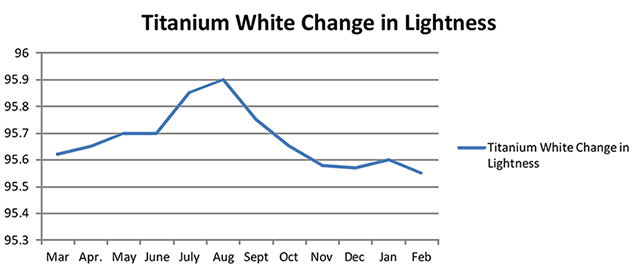
Looking at the chart of change in lightness on a field of all values from 0-100, you can see that there is very little change. In fact the change is imperceptible to the eye. But the photo spectrometer is incredibly sensitive and in looking at the chart below (detail of the chart to the right) you can see that there are changes in the lightness of the white over the course of a year.
Notice where the L* value dips? This is when it is cloudy for a few days before measurement, and where L* raises, this is when it is sunny. To the eye one could not detect a change in color in the samples from month to month, but the spectrophotometer is sensitive enough to measure subtlest of shifts in color.
This gives us the understanding that the color of a painting changes not only when it is stored in the dark and brought into the light, but is changing throughout its life however imperceptibly, in response to the amount of light it receives.
Box 2
L*a*b*
Since each color has the three attributes of hue value and intensity, it takes at least two graphs of each color sample to tell a complete story of the measurement of color and its changes. One graph, based on L*, shows Lightness or value, and another, based on the a* & b* values show how that color moved through color space if that space was flat, like a normal artists color wheel.
L*a*b*
Since each color has the three attributes of hue value and intensity, it takes at least two graphs of each color sample to tell a complete story of the measurement of color and its changes. One graph, based on L*, shows Lightness or value, and another, based on the a* & b* values show how that color moved through color space if that space was flat, like a normal artists color wheel.
Change of Color from Storage in the Dark
It is clear that the changes we are measuring only become perceptible in extremes of painting and storage, such as in a painting with large, thick areas of white that receive little light.
The graphs below address this question, first is a graph of the lightness of Titanium White drawn down without medium in early December. The Light Aged drawdown spent the year in the normal light and dark cycles which occur every day. The Dark Aged drawdown dried in the light and was stored in total darkness until April. Then was immediately measured and returned to total darkness until October, measured, and then brought out into the light and measured again after a week in normal natural light.
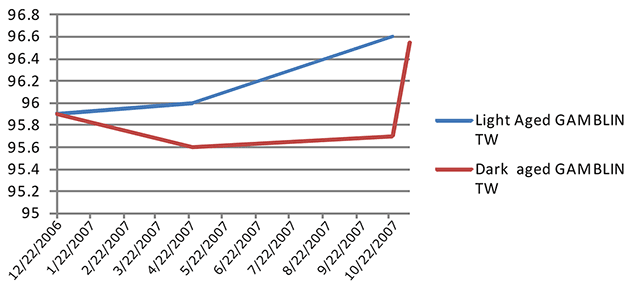
The Light aged sample measured lighter each of the two times it was measured over the year. The Dark aged sample showed an approximate .3 % reduction in lightness over the time it was in the dark. Shortly after being brought back into the light it regained it original color and matched the light aged sample in lightness.
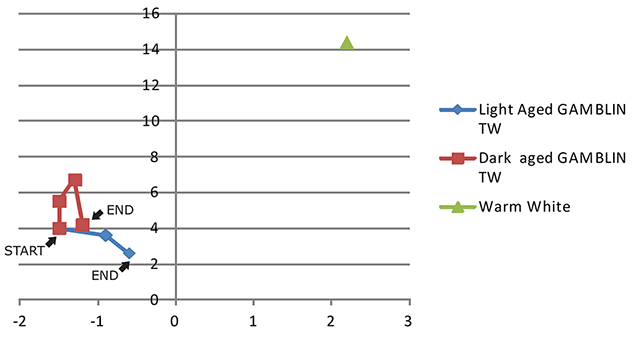
But the “degree of color” component expressed in the a*b* graph illustrates how oil changes color in response to light levels. The Light Aged sample moved in the direction of zero, (zero is totally neutral in color), the bleaching effect of the light made the oil paler in color over the year. The Gamblin Warm White measurement is just for comparison to show how small are the changes in the white we are talking about.
The Dark Aged sample gained color from being stored in the dark, but when brought into the light recovered its color to the point when it was put into the dark. In other words it recovered its original color. Any difference would be most likely be imperceptible to the eye.
Change in Color When Medium is added
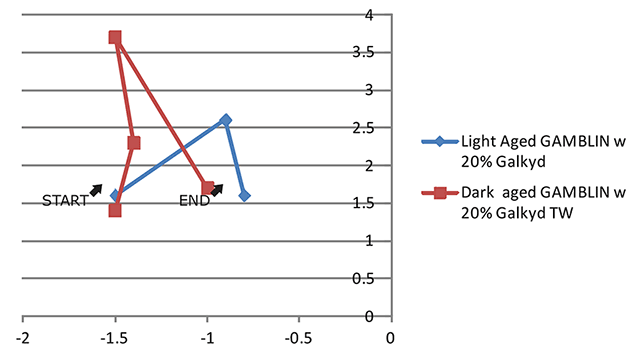
Now that this is clear, let’s ask the question what happens when one adds medium, which essentially adds more binder to the paint? The graph above shows what happened to Titanium White when 20% Galkyd was added. We have the exact same type of movement we saw in pure paint. The Light Aged sample got less color over the year; the Dark aged sample gained in color in the dark, but nearly matched the light aged sample in color by the end of the study.
The Effect of Heat on the Color of Oil
We also wanted to look at the effect of heat aging since we know that many oil paintings are stored in the dark in hot garages and attics over the summer months. And what about glazes? How do they perform since they are so rich in binder. We were able to get a look at both questions by aging pure films of Galkyd in the light, dark, and hot dark.
This graph is a little difficult to see because so many points are clustered in one area. The Galkyd aged in the light just moved around one tight area of the graph, it’s color changing imperceptibly. And since Galkyd is pure binder it took on a lot of color in the dark, and even more so in the hot dark. But after a month of being returned to the light, both samples recovered their color to similar to the sample that had aged in the light the whole time.
This test was by far the most dramatic example of paint/mediums aging in the dark for a year or more, and then recovering their original color when brought back into the light.
This is a good example of why we recommend using a varnish such as Gamvar for the final coat on a painting rather than a coat of a painting medium. Gamvar, since it is not made of oil, will not go through these light/dark color shifts.
Conclusions
The few graphs above are representative of the relatively large study we did, and our studies concur with the knowledge passed down to us through the centuries of oil painting, and with Henry Levinson’s tests.
Oil colors in a dried oil painting take on color in the dark, and bleach back out in the light. And we found that mediums act the same way as pure oil colors.
This leads to one more recommendation: that work be brought out of storage before an expected viewing and put into bright light for a few days.
As artists we understand that our paintings are in partnership with light, and that our work appears differently in different temperatures and levels of light. But the studies above also point out that light levels are constantly affecting the color in a painting. And we find it to be profound that the painting we thought was finished is subtly changing in response to where it is hanging, the time of day, and the brightness of the season.
We have always thought that a painting has two lives, the one it has on the easel while being created, and the second one that begins when the artist says, “it’s done.” This study shows that paintings in their second lives are not inanimate objects, they are dynamic (always active or changing), in subtle ways.
(1) Henry W. Levison, Artists Pigments Lightfastness Tests and Ratings
(Hallandale, FL, COLORLAB, 1976) p. 31
